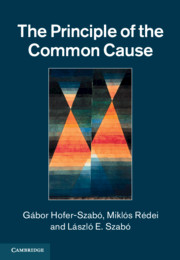Book contents
- Frontmatter
- Contents
- Preface
- 1 Introduction and overview
- 2 The Common Cause Principle
- 3 Common cause extendability of probability spaces
- 4 Causally closed probability theories
- 5 Common common causes
- 6 Common cause extendability of nonclassical probability spaces
- 7 Reichenbachian common cause systems
- 8 Causal closedness of quantum field theory
- 9 Reichenbach's Common Cause Principle and EPR correlations
- 10 Where do we stand?
- Appendix
- References
- Index
5 - Common common causes
Published online by Cambridge University Press: 05 June 2013
- Frontmatter
- Contents
- Preface
- 1 Introduction and overview
- 2 The Common Cause Principle
- 3 Common cause extendability of probability spaces
- 4 Causally closed probability theories
- 5 Common common causes
- 6 Common cause extendability of nonclassical probability spaces
- 7 Reichenbachian common cause systems
- 8 Causal closedness of quantum field theory
- 9 Reichenbach's Common Cause Principle and EPR correlations
- 10 Where do we stand?
- Appendix
- References
- Index
Summary
Common causes and common common causes
Proposition 3.9 tells us that every common cause incomplete classical probability space can be strongly common cause extended with respect to any (finite) set of correlations; Proposition 4.19 states that every classical probability space is even common cause completable. Note that what these propositions say is not that for a set of correlations between (Ai, Bi)(i = 1, 2 …n) there exists a single, common common cause C in the extension (or completion) for the whole set of correlations; in fact, the common causes Ci constructed explicitly in the proof of Proposition 3.9 are all different: Ci ≠ Cj (i ≠ j). This observation leads to the following question.
Let (Ai, Bi)(i = 1, … n)be a finite set of pairs of events in(X, S, p)that are correlated [Corrp(Ai, Bi) > 0 for every i]. We say that C is a common common cause of these correlations if C is a Reichenbachian common cause of the correlated pair (Ai, Bi)for every i. Does every set of correlations in a classical probability space have a common common cause?
In view of the generality of this question one may surmise that the answer to it is “yes”; that is to say, one may conjecture that given any two correlations there can always exist a Reichenbachian common cause which is a common cause for both correlations, since, one may reason, we just have to refine our picture of the world by adding more and more events to the original event structure in a consistent manner, and finally we shall find a single common cause that explains both correlations.
- Type
- Chapter
- Information
- The Principle of the Common Cause , pp. 51 - 59Publisher: Cambridge University PressPrint publication year: 2013



